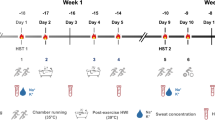Summary
This study examined the effect of acute exposure of the whole body to cold on blood lactate response during incremental exercise. Eight subjects were tested with a cycle ergometer in a climatic chamber, room temperature being controlled either at 24° C (MT) or at −2° C (CT). The protocol consisted of a step increment in exercise intensity of 30 W every 2 min until exhaustion. Oxygen consumption (\(\dot V_{{\text{O}}_{\text{2}} } \)) was measured at rest and during the last minute of each exercise intensity. Blood samples were collected at rest and at exhaustion for estimations of plasma norepinephrine (NE), epinephrine (E), free fatty acid (FFA) and glucose concentrations, during the last 15 s of each exercise step and also during the 1st, 4th, 7th, and the 10th min following exercise for the determination of blood lactate (LA) concentration. The\(\dot V_{{\text{O}}_{\text{2}} } \), was higher during CT than during MT at rest and during nearly every exercise intensity. At CT, lactate anaerobic threshold (LAT), determined from a marked increase of LA above resting level, increased significantly by 49% expressed as absolute\(\dot V_{{\text{O}}_{\text{2}} } \), and 27% expressed as exercise intensity as compared with MT. The LA tended to be higher for light exercise intensities and lower for heavy exercise intensities during CT than during MT. The E and NE concentrations increased during exercise, regardless of ambient temperature. Furthermore, at rest and at exhaustion E concentrations did not differ between both conditions, while NE concentrations were greater during CT than during MT. Moreover, an increase of FFA was found only during CT. The difference in FFA level suggests that alterations in fat metabolism, possibly initiated by an enhanced secretion of NE, may have contributed to a decrease in lactate production.
Similar content being viewed by others
References
Bergh U, Eckblom B (1979) Physical performance and peak aerobic power at different body temperatures. J Appl Physiol 46:885–889
Bergh U, Harley H, Lansberg L, Eckblom B (1979) Plasma norepinephrine concentration during submaximal and maximal exercise at lowered skin and core temperatures. Acta Physiol Scand 106:383–384
Blomstrand E, Essen-Gustavsson B (1987) Influence of reduced muscle temperature on metabolism in type I and type II human muscle fibres during intensive exercise. Acta Physiol Scand 131:569–574
Blomstrand E, Bergh U, Essen-Gustavsson B, Eckblom B (1984) Influence of low muscle temperature on muscle metabolism during intense dynamic exercise. Acta Physiol Scand 120:229–236
Brooks GA (1985) Anaerobic threshold review of the concept and direction for future research. Med Sci Sports Exerc 7:150–154
Brooks GA (1986) Lactate production under fully aerobic conditions: the lactate shuttle during rest and exercise. Fed Proc 45:2924–2929
Da Prada M, Zurcher G (1976) Simultaneous radioenzymatic determination of plasma and tissue adrenaline, noradrenaline and dopamine within the femtomole range. Life Sci 19:1161–1174
Dole VP, Meinertz H (1960) Microdetermination of long chain fatty acids in plasma and tissues. J Biol Chem 235:2595–2599
Dolny DG, Lemon WR (1988) Effect of ambient temperature on protein breakdown during prolonged exercise. J Appl Physiol 64:550–555
Galbo H, Houston ME, Christensen NJ, Holst JJ, Nielsen B, Nygaard E, Suzuki J (1979) The effect of water temperature on the hormonal response to prolonged swimming. Acta Physiol Scand 105:326–337
Himms-Hagen J (1967) Sympathetic regulation of metabolism. Pharmacol Rev 19:367–461
Hohorst HJL (1965) Lactate determination with lactic deshydrogenase and DPN. In: Bergmeyer HU (ed) Method of enzymatic analysis. Academic Press, New York, pp 266–270
Holmer I, Bergh U (1974) Metabolic and thermal response to swimming in water at varying temperatures. J Appl Physiol 37:702–705
Howley ET, Cox R, Welch HG, Adams RP (1983) Effect of hyperoxia on metabolic and catecholamine responses to prolonged exercise. J Appl Physiol Respir Environ Exercise Physiol 54:59–63
Hughson RL, Weisiger KH, Swanson GD (1987) Blood lactate concentration increases as a continuous function in progressive exercise. J Appl Physiol 62:1975–1981
Ivy JL, Costill DL, Van Handel PJ, Essig P, Lower RW (1980) Alteration in the lactate threshold with changes in substrate availability. Int J Sports Med 48:523–527
Jacobs I, Romet TT, Kerrigan-Brown D (1985) Muscle glycogen depletion during exercise at 9° C and 21° C. Eur J Appl Physiol 54:35–39
Jorfeldt L (1970) Metabolism of L(+)lactate in human skeletal muscle during exercise. Acta Physiol Scand [Suppl] 338:5–67
Lucas A, Therminarias A, Tanche M (1980) Maximum oxygen consumption in dogs during muscular exercise and cold exposure. Pflügers Arch 388:83–87
Minaire Y, Pernod A, Jomain MJ, Mottaz M (1971) Lactate turnover and oxidation in normal and adrenal-demedullated dogs during cold exposure. Can J Physiol Pharmacol 49:1063–1070
Ramanathan NL (1966) A new weighing system for mean surface temperature of the human body. J Appl Physiol 19:531–533
Simon J, Young JL, Gutin B, Blood DK, Case RB (1983) Lactate accumulation relative to the anaerobic and respiratory compensation thresholds. J Appl Physiol 54:13–17
Stanley WC, Gertz EG, Wisneski JA, Morris DL, Neese RA, Brooks GA (1985) Systemic lactate kinetics during graded exercise in man. Am J Physiol 249 (Endocrinol Metab 12):E595-E602
Tesch PA, Daniel WL, Sharp DS (1982) Lactate accumulation in muscle and blood during submaximal exercise. Acta Physiol Scand 114:441–446
Therminarias A, Chirpaz MF, Lucas A, Tanche M (1979) Catecholamines in dogs during cold adaptation by repeated immersions. J Appl Physiol 46:662–668
Wasserman K, Whipp GJ, Koyal SN, Beauer WL (1973) Anaerobic threshold and respiratory gas exchange during exercise. J Appl Physiol 35:236–243
Author information
Authors and Affiliations
Rights and permissions
About this article
Cite this article
Therminarias, A., Flore, P., Oddou-Chirpaz, M.F. et al. Influence of cold exposure on blood lactate response during incremental exercise. Europ. J. Appl. Physiol. 58, 411–418 (1989). https://doi.org/10.1007/BF00643518
Accepted:
Issue Date:
DOI: https://doi.org/10.1007/BF00643518




